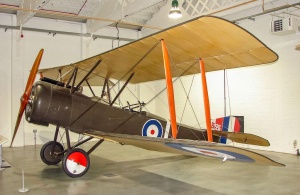The Sopwith 1 1/2 Strutter was a British two seat multi-role biplane aircraft operated by both the Royal Naval Air Service (RNAS) and the Royal Flying Corps (RFC)/Royal Air Force (RAF) during World War I. It was given the name 1 1/2 Strutter because of the long and short cabana struts that supported the top wing.
Design work on the aircraft commenced in 1914 and the first prototype was ready by mid-December 1915 and underwent testing in January 1916. The 1 1/2 Strutter was of conventional wire-braced, wood and fabric construction. The pilot and gunner sat in widely separated tandem cockpits, with the pilot in front, giving the gunner a good field of fire for their Lewis gun. It also had a forward firing .303 Vickers machine gun operated by the pilot.
By the end of April 1916 the aircraft was in service with the RNAS and by July of that year, with the RFC. Initially the aircraft performed well against its German opponents but by early 1917 it was being outclassed by new German aircraft types. Like many other early Sopwith type aircraft, the 1 1/2 Strutter was very lightly built and its airframe did not stand up well to arduous war service. It was far too stable to make a good ‘dog-fighting’ aircraft and the distance between the pilot and the observer's cockpits hampered communication.
The last operational 1 1/2 Strutters in the RFC were replaced by Sopwith Camels in late October 1917. The RNAS used most of their 1 1/2 Strutters as bombers (in the Mediterranean theatre as well as in France) and on board ships, where it was known as the Ship's Strutter. It flew from several Royal Navy warships and from the battlecruiser HMAS Australia. By 1918 the aircraft was used mainly as a trainer having been withdrawn from operational service.
Around 1,500 1 1/2 Strutters were built for the RFC and the RNAS and approximately 4,500 were built in France. The aircraft was also operated by Belgium, Japan, Poland, Russia and the United States.
Specifications
 |
| Type |
Reconnaissance Aeroplane |
|---|---|
| Manufacturer |
Mann Egerton & Co Ltd, UK |
| Number in use |
Three - N5644 (March to May 1918), A6968 (mid-1918), F7562 (late 1918) |
| Length |
25 feet 3 inches |
| Height |
10 feet 3 inches |
| Weights | 1305 |
| Dimensions | Wing span: 33 feet 6 inches |
| Speed | 102 mph |
| Crew |
2 |
| Engines | One 130hp Clerget |
| Performance |
|
| Armament |
Guns: 1 x Vickers MG, 1 x Lewis MG, Bombs: 2 x 65 lb |
| Ships embarked in | HMAS Australia (I) |
